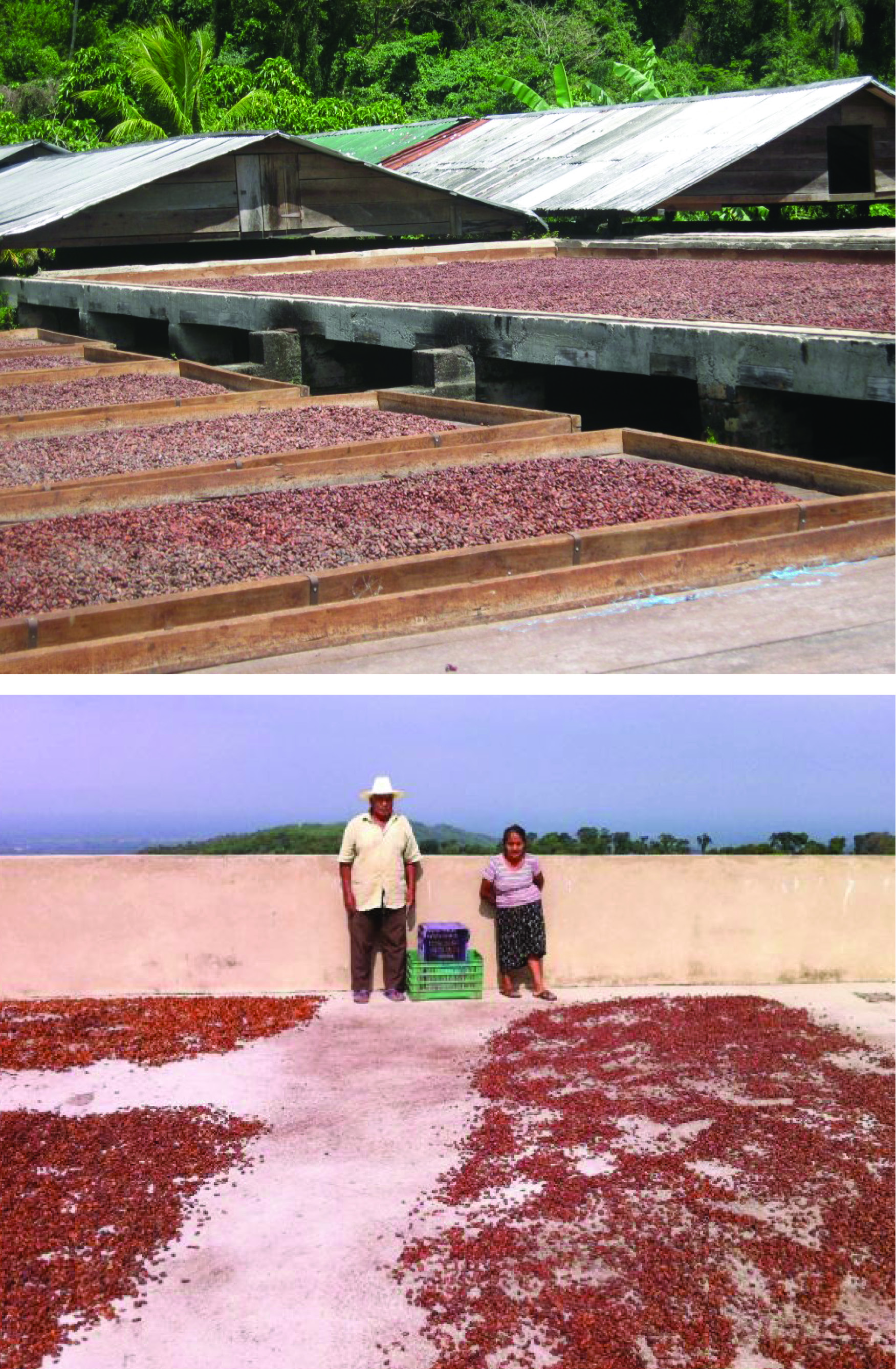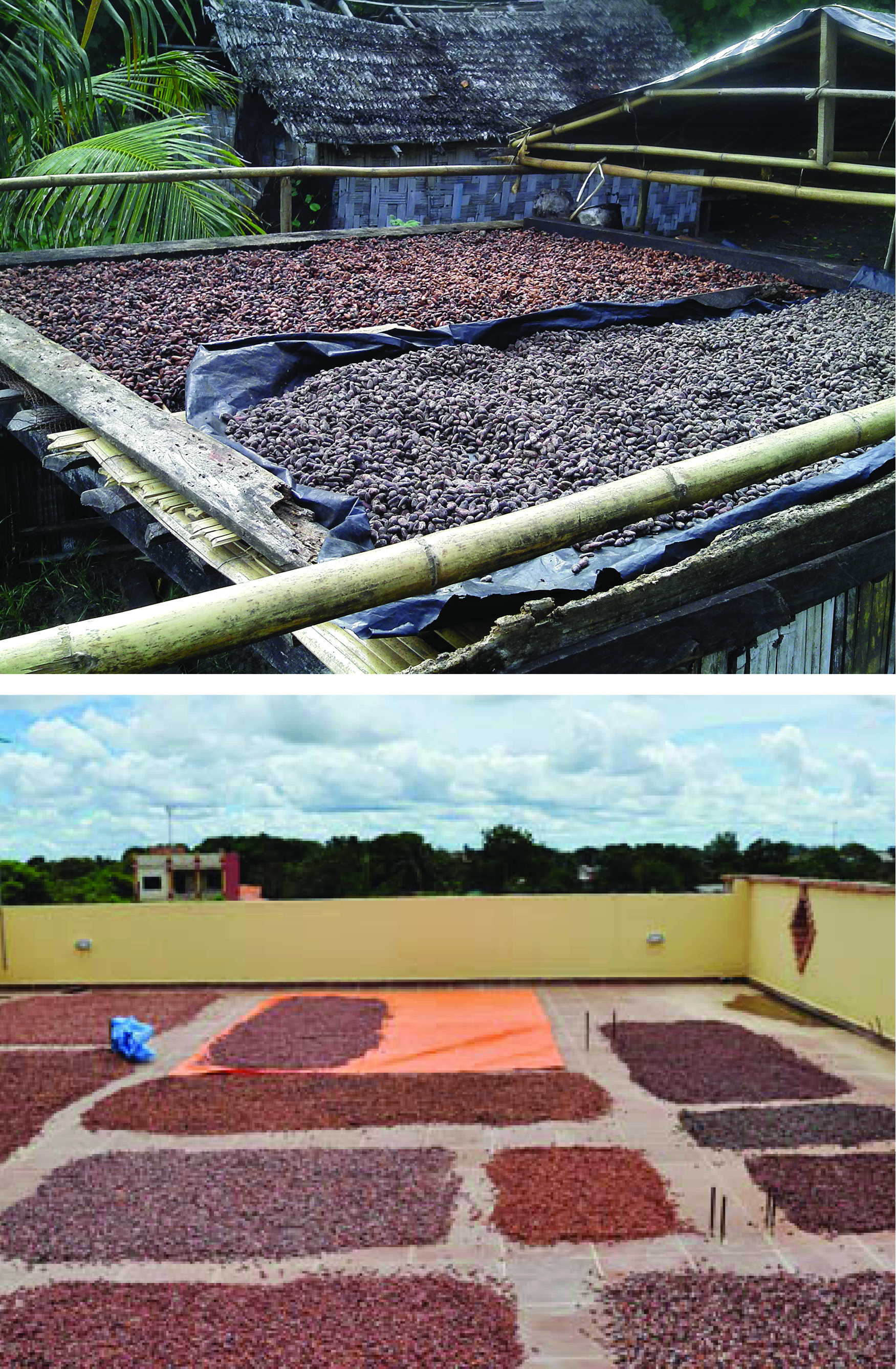chocolate skyline

Cacao “beans” drying on a rooftop in Ghana || photo by Toby Webb
This Valentine’s Day season I’d like to be as close to chocolate as possible, and consumer market trends suggest that I’m not alone. For those of us living far from the equator, though, the main ingredient in chocolate, cacao, travels an incredible distance to reach our plates. Cacao are seeds, often referred to as “beans,” found within football-shaped pods that grow from the trunk and branches of the cacao tree (Theobroma cacao). The tree is native to the South American lowlands and is now propagated within rainforests throughout the equatorial tropics and sub-tropics of Central America and parts of South America, Africa, and Asia.

Agricultural rooftop use in Granada (top) + Mexican farmers drying cacao out of their chickens’ reach (bottom) || photos by The Grenada Chocolate Company + Madre Chocolate/David Elliott
The process of deriving coco from the cacao bean is labor-intensive and is often performed by growers and plantation owners in remote areas. Once cacao pods ripen, they’re cut from the tree and the beans are extracted. The beans are fermented, laid on a flat surface to dry, and then generally exported to another country where they are roasted. The roasted beans are ground to a fine powder called cocoa, which is then blended with sugar and other ingredients to produce the creamy sweetness that we’ve grown to love.
“Cacao seeds, or ‘beans,’ have to be dried after fermentation as a measure to prevent molds [and] mildews from growing on them during transport,” explains botanical scientist and cacao expert Dr. Cindy Skema. “It is a bit of an art, though, because the beans must not be over-dried because they can become too brittle and that creates problems in processing.” As you may imagine, naturally flat areas for drying cacao beans are a rarity for many rainforest inhabitants. Some growers and plantation owners build structures specifically designed to dry the beans, with protective covers that are either static or slide on tracks, like a convertible roof, to protect the crop from incoming rain storms and shield the beans from insects and birds. Others lay beans on their village’s concrete, central square, as I’ve seen myself in rural Venezuela.
In isolated instances around the world growers have been seen industriously using their rooftops as drying grounds for cacao beans. Multiple examples exist in Trinidad, but growers and plantation owners in Brazil, Ghana, the Dominican Republic, Grenada (in the Caribbean), Vanuatu (in the South Pacific), and Mexico have also pursued the practice. In Oaxaca, Mexico, chocolatier consultant and author Clay Gordon visited a family farm that allocated roof areas to drying cacao because this location was, “out of the reach of chickens,” he says. Gordon explains, though, that drying cacao on roofs is not a common practice due primarily to, “the labor of getting the beans up there in the first place. Furthermore, not all roofs [in cacao-growing locations] are flat or sturdy – many of them are pitched and made of galvanized corrugated metal, which is not a good surface for drying beans.”

Cacao drying on rooftops in Vanuatu (top) + Trinidad (bottom) || photos by Zaia Kendall + Leonie Milner
Skema agrees that drying cacao on rooftops is not very common, but to her, the practice comes as no surprise. “It makes sense,” she says, “I mean [the roof] is a typically open, available space that gets very hot and is a bit cleaner than ground level, or at least without people [or] animals walking through.” Skema notes that around the world roofs are used to dry a variety of things, like edible plant material, meat, and clothes.
Agriculture involves not just food production, but also processing, or the preparation of crops for sale via washing, fermenting, drying, etc. Rooftop agriculture generally evokes images of crops strictly in production, even for me, and we rarely stop to think about supplementary agricultural practices fit for rooftops. Using roofs to dry cacao is a beautiful example of the creativity of farmers who, in all reaches of the world, have independently developed the same practice.
This Valentine’s Day, when you’re craving chocolate, pause to think about whether your indulgence spent part of its lifetime on a roof, under the sun, and what other non-production agricultural practices could occupy our rooftops.
—
Sources
Bletter, Nat. Email correspondance. 17 November 2015.
Gordon, Clay. Email correspondence. 18 November 2015.
Gordon, Clay. “Madre Chocolate-From The Road In Xoconusco, Chiapas.” Discover Chocolate, 7 March 2011. Web. 11 October 2015.
Skema, Cynthia. Email correspondance. 10 November 2015.
Skema, Cynthia. “Ka-Pow Cacao.” Morris Arboretum of the University of Pennsylvania. 100 E Northwestern Ave, Philadelphia, PA 19118. Lecture.
 EAT UP
EAT UP